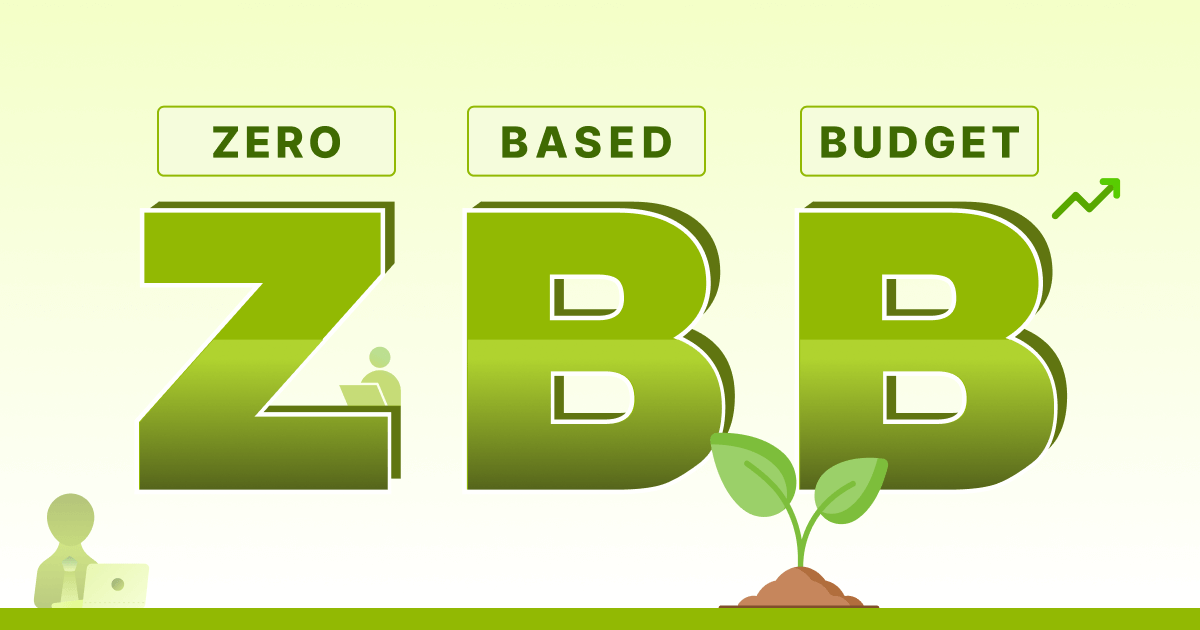Have you ever thought what the most cost-efficient budgeting strategy is? Well, there is no one answer to this query, but there is a unique concept known as “zero-based budgeting.” No, it does not mean spending no income on your budget. It’s actually a budgeting approach completely opposite to traditional budgeting techniques.
Excited to learn about it? So, let’s get into the nitty-gritty of zero-based budgeting and how to do it for organizations.
Definition of Zero-Based Budgeting
Zero-based budgeting (ZBB) is a strategic financial planning method in which all expenses are calculated and justified at the start of a new budgeting period. These calculations start from a “zero base.” Unlike traditional budgeting, where we adjust historic spending levels incrementally, ZBB requires a completely new evaluation of expenses.
Why is the ZBB method used in budgeting? The idea behind this is to allocate funds based on current needs and priorities rather than past budgets. This approach is a smart way to manage your resource allocation while maintaining cost efficiency and aligning spending with strategic objectives. It also reduces unnecessary costs that were included in the past budgets and creates a more disciplined and accountable budgeting process.
How to Create a Zero-Based Budget?
Making a zero budget plan takes on a systematic approach where every dollar of your income is allocated with proper analysis and purpose. All expenses have to be justified for the new budgeting period to have more financial efficiency.
Here is a simple step-by-step approach to explain zero-based budgeting:
1) List Down Objectives
In any financial activity, you first have to list down your objectives whether it is to save the most budget, get the most ROI, increase your savings, etc. These objectives will be the foundation of your budgeting process and will remind you to make sensible financial decisions that lead to your broader goals.
Objectives can be anything, like short-term goals like paying off debt or saving for a vacation. They can also be long-term goals such as building an emergency fund, saving for retirement, or investing in a home. The purpose is just to have a clear vision about them to set priorities and make informed decisions, and also be realistic about your goals.
2) Calculate Expenses
After setting up your objectives, you move on to calculate your expenses. Here you will have to give a detailed review of all your spending categories that include:
- fixed expenses (rent or mortgage payments, utilities, and insurance premiums)
- variable expenses (food and leisure, entertainment, and transportation).
It’s important to track your expenses over a few months to get an accurate picture of your spending habits. This step also includes identifying any irregular or seasonal expenses that may occur throughout the year. That’s how you gain insight into your financial commitments and can identify areas where you should cut costs or reallocate funds.
3) Build Budget Plans
All set with your objectives and expenses? The next step is the real deal because you will have to build your budget plans. This budget will allocate your income to various expense categories based on your priorities.
Start by calculating and listing down your total monthly income from all your earning sources. Then, allocate funds to obvious and more important expenses like rent, utilities, food bills, and transportation. After covering these essential needs, assign money to your objectives.
Remember that you are creating a zero-based budget where your income minus your expenses equals zero. This step requires careful planning, and you might have to adjust your spending habits frequently to align with your financial goals.
4) Prioritize Resources
With the budget plans in place, time to evaluate which projects and departments are more important for your organization’s objectives to allocate resources accordingly. Prioritization helps in making tough decisions about where to cut costs and where to invest more heavily.
Here’s an example template for you to try:
| Priority Level | Department | Objective | Requirements | Allocated Budget | Status |
| 1 (High) | Research & Development | Innovate new products | XYZ | $amount | Approved |
| 2 (High) | Marketing & Sales | Increase market share | XYZ | $amount | Approved |
| 3 (Medium) | IT Infrastructure | Upgrade systems | XYZ | $amount | Approved with adjustments |
| 4 (Medium) | Human Resources | Employee training programs | XYZ | $amount | Approved with adjustments |
| 5 (Low) | Facilities Management | Office renovations | XYZ | $amount | Partially Approved |
| 6 (Low) | Customer Service | Implement new support software | XYZ | $amount | Approved with adjustments |
5) Analyze and Monitor
How can we miss continuously analyzing and monitoring our budget’s performance? You have to review actual spending against the budgeted amounts to identify any variances. It is important to understand why these variances occur and take corrective actions as needed.
Continuous monitoring will keep your organization on track to meet its strategic objectives and stay competitive in a price-conscious market. This step will also promote accountability and a culture of financial discipline within the organization where everyone has to answer for overspending.
Advantages of Making a Zero-Based Budgeting Plan
So, what’s the real deal with zero-based budgeting plans that make it work out for organizations? Here are the benefits that you get from this financial planning approach:
1) Save More Bucks Than Ever
Zero-based budgeting maintains cost efficiency by requiring each expense to be justified before the budgeting period instead of in the middle of the year. That means you will not have to face unforeseen financial downfalls in case your budget is overspent. That’s why it highly focuses on allocating resources only to essential activities.
For example, multinational consumer goods giant Unilever implemented zero-based budgeting. Unilever’s CEO, Paul Polman, announced in 2016 that the company would implement ZBB globally after using it for the first time in Thailand for 1 year. It helped them cut costs and streamline their operations in a period that resulted in significant savings and improved financial performance.
2) More Power to Your Objectives
Objectives guide a company which is why zero-based budget is most suitable to make sure that spending is closely aligned with the organization’s strategic objectives. Since it starts from a “zero base,” managers can allocate funds to initiatives that directly support the company’s goals. This approach helps prioritize high-impact projects and reallocate funds from less critical areas.
Kraft Heinz is a notable example that adopted zero-based budgeting in 2015 to better align its spending with strategic priorities. Their spokesperson said that using this approach helped them save money that could be reinvested in other business strategies.
3) Everything is Clear and Accounted For
The requirement for a detailed justification of every expense in zero-based budgeting increases accountability and transparency within the organization. Managers are held responsible for providing a rationale for their budget requests, which promotes a culture of financial responsibility and scrutiny. This level of transparency can help in pointing out inefficiencies and areas where costs can be reduced.
Just like PepsiCo did in 2016 by adopting zero-based budgeting in response to declining sales. An interesting fact is that the company expected to save $1 billion per year from ZBB. However, their analysis revealed that PepsiCo’s budgeted estimates were often higher than revised estimates.
The company only achieved its targets 80% of the time. This 0-base analysis helped them take corrective actions to allocate their resources in a better way and save those extra costs.
4) There Is Room For Adaptation
Zero-based budgeting is your chance to gain greater flexibility compared to traditional budgeting methods. Since budgets are built from scratch each period, organizations can more easily adapt to changing business environments and shifting priorities.
This adaptability is particularly beneficial in dynamic industries where rapid response to market changes is needed. 3G Capital’s implementation of zero-based budgeting in its portfolio companies is an example of this. It allowed them to do agile financial planning and quick adjustments to market conditions.
5) No Resources Will Go To Waste
Zero-based budgeting approach allows for focused resource allocation so that funds are directed toward the most important and productive areas of the business. It helps to prevent the misallocation of resources and promotes investment in high-return projects so that money is not wasted on failed pursuits.
Like Coca-Cola started in 2014 by using zero-based budgeting to focus its resources on growth initiatives and improve its financial health. They were in the midst of facing decreased global demand for soft drinks as awareness was rising for health concerns regarding sugary drinks. But cost-cutting measures like 0 base saved them from this downfall.
6) Discipline Keeps It All Going Well
Zero-based budgeting is a good model for a better organizational culture. How so? Well, a culture of financial discipline within the organization is the best way to inform your employees about not wasting resources and energy. The detailed scrutiny of expenses and the need for justification encourage managers to think critically about their spending and prioritize cost-effective solutions.
This disciplined approach to budgeting helps organizations maintain tight control over their finances and avoid wasteful spending. That’s why General Electric (GE) also adopted zero-based budgeting to maintain financial discipline and improve cost management across its various divisions.
Comparison Between ZBB Budget Vs Traditional Budgeting
Yeah, you now understand what zero-based budgeting is, but do you know what separates it from the traditional system? Let’s compare these approaches to see which one fits your organization or household best:
Expense Justification
- Zero-based budgeting requires every expense to be justified from scratch for each new period.
- Traditional budgeting justifies expenses based on historical data like a percentage increase or decrease from past patterns.
Focus and Approach
- ZBB focuses on current needs and strategic goals, promoting a thorough evaluation of all expenses.
- Traditional budgeting focuses on maintaining continuity by adjusting the previous year’s budget based on expected changes.
Flexibility and Efficiency
- Zero-based budgeting is highly flexible, allowing for significant changes in budget allocations based on current needs.
- Traditional budgeting is less flexible as it follows the historical spending patterns.
Time, Effort, and Transparency
- Implementing zero-based budgeting requires significant time and effort, as every expense must be detailed analyzed and justified.
- Traditional budgeting is less time-consuming since it builds on previous budgets with minor adjustments.
Strategic Alignment and Accountability
- Zero-based budgeting ensures strong alignment with strategic goals, as budgets are built based on current priorities and needs.
- Traditional budgeting has weaker alignment with strategic goals, as past spending patterns can influence budgets.
Cost Control and Implementation
- ZBB is effective for cost control and identifying and eliminating unnecessary expenditures.
- While traditional budgeting is less effective for cost control, it is suitable for organizations looking for stability and continuity in budgeting with minor annual adjustments.
Summary
Zero-based budgeting planning is inherently different from traditional budget plans, as the latter is based on starting from zero in each financial accounting cycle. The difference between the two signifies that each approach has its own pros and cons. It’s up to your financial objectives to choose which approach is better for your company but zero-based is a unique tactic to maintain cost efficiency.
So, try out these 5 steps of zbb zero-based budgeting and see if it brings out the best of your accounting cycle.
FAQs
Q. What is the difference between Zbb budgeting from baseline budgeting?
Zero-based budgeting (ZBB) starts from a “zero base,” which asks for justification for every expense. On the other hand, baseline budgeting adjusts the previous year’s budget with gradual changes.
Q. Why is 50/30/20 rule used in Zbb zero-based budgeting?
The 50/30/20 rule is a helpful ratio used in ZBB to simplify the allocation process by dividing income into 50% for needs, 30% for wants, and 20% for savings and debt repayment.
Q. Do companies use zero-based budgeting?
Yes, many companies use zero-based budgeting to confirm that every expense is necessary and aligned with their strategic goals without wasteful spending.




















